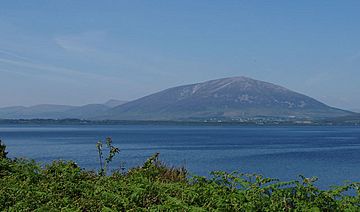Nephin facts for kids
Quick facts for kids Nephin |
|
|---|---|
| Néifinn | |

Nephin with Lough Conn
|
|
| Highest point | |
| Elevation | 806 m (2,644 ft) |
| Prominence | 778 m (2,552 ft) |
| Listing | P600, Marilyn, Hewitt |
| Geography | |
|
Lua error in Module:Location_map at line 420: attempt to index field 'wikibase' (a nil value).
|
|
| Location | County Mayo, Republic of Ireland |
| Parent range | Nephin Beg Range |
| OSI/OSNI grid | G103079 |
Nephin or Nefin (Irish: Néifinn) is a tall mountain in Ireland. It stands 806 metres (2,646 feet) high. Nephin is the highest mountain that stands alone in Ireland. It is also the second-highest peak in Connacht, after Mweelrea. You can find it west of Lough Conn in County Mayo.
The name Néifinn can mean different things. Some say it means 'heavenly' or 'sanctuary'. Others believe it means "Finn's Heaven".
Contents
Where is Nephin Located?
Nephin is in the middle of an area called Gleann Néifinne. This area has Lough Conn to its east. To the south, you'll find the Windy Gap/Barnageehy. Birreencorragh mountain is to the west. In the past, its northern edge was the townland of Ballybrinoge. This is in the parish of Crossmolina.
Nephin's Ancient History
Nephin is a very old mountain. It is mentioned in an ancient Irish story called Cath Maige Tuired. This story calls Nephin one of the "twelve chief mountains" of Ireland. In the text, its name was Nemthenn. This old name might be linked to nemeton. A nemeton was a special, sacred place in ancient Celtic religion.
Long ago, a group of people called the Gamarad lived in this area. They were kings of Connacht before recorded history. One of their kings was Ailill Finn. He lived at a place called Dun Atha Fene. Today, this spot is known as Caorthannan/Castlehill townland. It is in the parish of Addergoole and Crossmolina.
There is a famous legend about a cattle raid on King Ailill Finn and his wife Flidais. This story is known as the Mayo Táin.
Nephin was very important in the past. In the year 1111, a big meeting called the Synod of Raith Bressail happened. At this meeting, they decided that Nephin would be the northern border of the diocese of Cong. A diocese is an area managed by a church leader.
Who Lived Around Nephin?
Over many centuries, different families and groups lived around Nephin.
- The O Lachtna family were important lords in the 12th century. Their name later changed to Loughnane or Loftus.
- Later, a group called the Mac Diarmada family moved into the area. This happened in the 12th century.
- After the Anglo-Norman people came to Connacht, new families took over. The Clann Ricinh Baireid became the new owners.
- Then, in the 14th century, the Bourke family slowly took control from the Barrett family.
- A story called The Welshmen of Tirawley tells about how the Barrett family settled in Glen Nephin. It also describes a long conflict between the Bourkes, the Barretts, and their tenants.
In the early 1600s, the Barrett and Bourke families still owned land here. But after the Irish Confederate Wars ended in 1653, their land was taken away. This was done by forces loyal to Oliver Cromwell. By 1666, new owners like Jackson and Gore had taken over.
The area around Glen Nephin remained a Gaeltacht until the late 1800s. A Gaeltacht is a place where the Irish language is still spoken every day.
Nephin in Movies
Mount Nephin was featured in the 2020 movie Wild Mountain Thyme.


